Strategic Information Systems for Business and Enterprise
VerifiedAdded on 2023/01/06
|10
|2843
|80
AI Summary
This study material covers various topics related to strategic information systems for business and enterprise. It includes discussions on advanced transaction management systems, risks in payroll systems, risks in manufacturing companies, and more. The material provides insights into the importance of technology, economics, legal aspects, operations, and scheduling in system development. It also highlights the role of accountants in the system development cycle.
Contribute Materials
Your contribution can guide someone’s learning journey. Share your
documents today.

Strategic
Information
Systems for
Business and
Enterprise
Information
Systems for
Business and
Enterprise
Secure Best Marks with AI Grader
Need help grading? Try our AI Grader for instant feedback on your assignments.
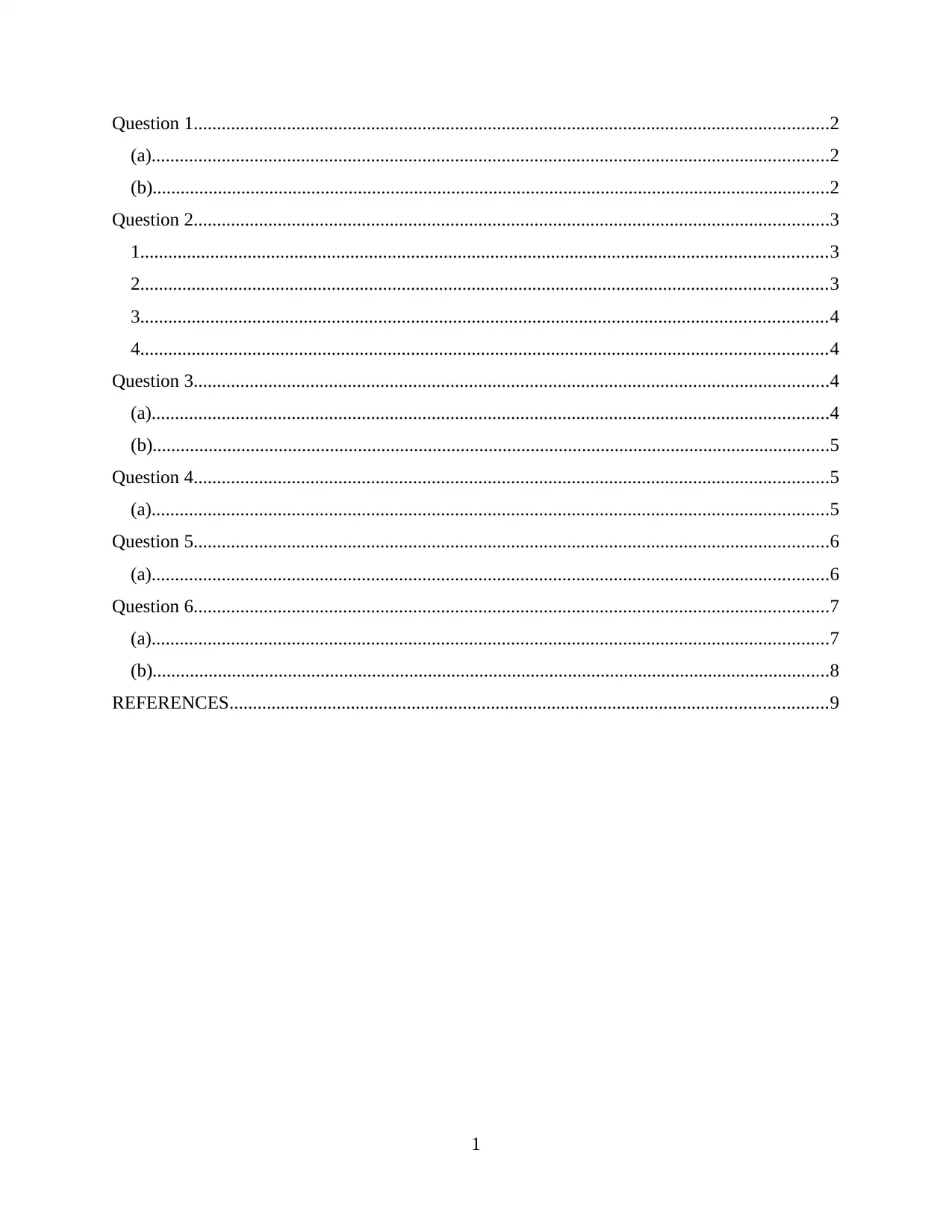
Question 1........................................................................................................................................2
(a).................................................................................................................................................2
(b).................................................................................................................................................2
Question 2........................................................................................................................................3
1...................................................................................................................................................3
2...................................................................................................................................................3
3...................................................................................................................................................4
4...................................................................................................................................................4
Question 3........................................................................................................................................4
(a).................................................................................................................................................4
(b).................................................................................................................................................5
Question 4........................................................................................................................................5
(a).................................................................................................................................................5
Question 5........................................................................................................................................6
(a).................................................................................................................................................6
Question 6........................................................................................................................................7
(a).................................................................................................................................................7
(b).................................................................................................................................................8
REFERENCES................................................................................................................................9
1
(a).................................................................................................................................................2
(b).................................................................................................................................................2
Question 2........................................................................................................................................3
1...................................................................................................................................................3
2...................................................................................................................................................3
3...................................................................................................................................................4
4...................................................................................................................................................4
Question 3........................................................................................................................................4
(a).................................................................................................................................................4
(b).................................................................................................................................................5
Question 4........................................................................................................................................5
(a).................................................................................................................................................5
Question 5........................................................................................................................................6
(a).................................................................................................................................................6
Question 6........................................................................................................................................7
(a).................................................................................................................................................7
(b).................................................................................................................................................8
REFERENCES................................................................................................................................9
1

Question 1
(a)
Advanced transaction management system leads to a supporting tool that supports to
document and track daily basis transactions in an enterprise (Banaeianjahromi and Smolander,
2019). They help to reduce potential fraud by using several ways and these are discussed below:
Actual time transaction processing: When transaction is reported only at the time of the
act, the risks of omission are minimized and, as a consequence, the fraud is immediately
identified.
Reduced processing time: Previously, organizations used to be a large amount of time
spent on processing and finalising transactions, during which time, the risks of fraudulent
activity were high but now because of advanced transaction processing system,
processing time was significantly reduced and thus the likelihood of fraud are minimal.
The transaction processing system: It allows only a few users to access data, enhances
the protection of the organisation's private information and also reduces the amount of
fraud that really can occur unless the data leaks from the organisation.
Effective communication: It has been identified that, communication
among members improved with support of TPS communication. This communication
aims to limit fraud, because everyone in the company is now transparent of all
transactions and so there is no misunderstanding.
In order to reduce manual errors which can lead towards less errors and less fraud? Each
transaction and related details are completely obvious in this system. This transparency and
accountability leads to better governance and less fraud.
(b)
With the reference of given flowchart, some features identified and it will be classified
into four divisions such as: sales department, accounting department, warehouse, shipping
department and billing department. They play their defined roles in business, and also have some
gaps which can be used for any fraudulent activity mentioned below:
Sales invoices go straight to the payroll department and therefore do not follow cross-
checking from the accounting department; this discrepancy can be seen as an extra fee
from customer or some other error in the checkout process.
2
(a)
Advanced transaction management system leads to a supporting tool that supports to
document and track daily basis transactions in an enterprise (Banaeianjahromi and Smolander,
2019). They help to reduce potential fraud by using several ways and these are discussed below:
Actual time transaction processing: When transaction is reported only at the time of the
act, the risks of omission are minimized and, as a consequence, the fraud is immediately
identified.
Reduced processing time: Previously, organizations used to be a large amount of time
spent on processing and finalising transactions, during which time, the risks of fraudulent
activity were high but now because of advanced transaction processing system,
processing time was significantly reduced and thus the likelihood of fraud are minimal.
The transaction processing system: It allows only a few users to access data, enhances
the protection of the organisation's private information and also reduces the amount of
fraud that really can occur unless the data leaks from the organisation.
Effective communication: It has been identified that, communication
among members improved with support of TPS communication. This communication
aims to limit fraud, because everyone in the company is now transparent of all
transactions and so there is no misunderstanding.
In order to reduce manual errors which can lead towards less errors and less fraud? Each
transaction and related details are completely obvious in this system. This transparency and
accountability leads to better governance and less fraud.
(b)
With the reference of given flowchart, some features identified and it will be classified
into four divisions such as: sales department, accounting department, warehouse, shipping
department and billing department. They play their defined roles in business, and also have some
gaps which can be used for any fraudulent activity mentioned below:
Sales invoices go straight to the payroll department and therefore do not follow cross-
checking from the accounting department; this discrepancy can be seen as an extra fee
from customer or some other error in the checkout process.
2

Sales order and inventory reveal are consolidated into one process that may generate a
gap in the process since it will lead with no cross-checking by the payroll department.
The different procedures in the flowchart are duplicated. Duplication of a specific task is
not only expensive and time taking, but also contributes to illegal practises, as workers
are overwhelmed and there would be less communication throughout the process.
Some of the procedures are brought to an immediate halt only in the middle of the process.
This gap could be used for unfair practises. This flow chart does not clearly symbolise all
processes and also create confusion and a breach of unfair practise.
Question 2
1
In alternate option two that there's no duplicate work as buying order goes straight to their
specific departments (Dzwigol and et.al., 2019). For example: a blind copy goes straight to
the recipient, a copy of accounts payable leads straight to the paying department, and then
the same every document.
There is also no repetition of work, resulting in increased productivity and efficient
organisational operations.
There is no backup of file in alternative option to prepare a specific transaction list that
decreases manual work and thus enhances efficiency.
Due to decreased duplication of effort and consistent operations, everybody is informed
about their duties and responsibilities.
2
Basis Purchase requisition Purchase order
Meaning It is demanded that the
purchase be made in relation
to the stock.
It is provide the confirmation
of purchase order.
Initiated by whom This could be generated by
any individual who finds the
need to do.
It can only be done by the purchasing
division or the member of that
particular department.
Receiver This shall be forwarded to the
purchasing department
It was received by the supplier
after approve the final order.
3
gap in the process since it will lead with no cross-checking by the payroll department.
The different procedures in the flowchart are duplicated. Duplication of a specific task is
not only expensive and time taking, but also contributes to illegal practises, as workers
are overwhelmed and there would be less communication throughout the process.
Some of the procedures are brought to an immediate halt only in the middle of the process.
This gap could be used for unfair practises. This flow chart does not clearly symbolise all
processes and also create confusion and a breach of unfair practise.
Question 2
1
In alternate option two that there's no duplicate work as buying order goes straight to their
specific departments (Dzwigol and et.al., 2019). For example: a blind copy goes straight to
the recipient, a copy of accounts payable leads straight to the paying department, and then
the same every document.
There is also no repetition of work, resulting in increased productivity and efficient
organisational operations.
There is no backup of file in alternative option to prepare a specific transaction list that
decreases manual work and thus enhances efficiency.
Due to decreased duplication of effort and consistent operations, everybody is informed
about their duties and responsibilities.
2
Basis Purchase requisition Purchase order
Meaning It is demanded that the
purchase be made in relation
to the stock.
It is provide the confirmation
of purchase order.
Initiated by whom This could be generated by
any individual who finds the
need to do.
It can only be done by the purchasing
division or the member of that
particular department.
Receiver This shall be forwarded to the
purchasing department
It was received by the supplier
after approve the final order.
3
Secure Best Marks with AI Grader
Need help grading? Try our AI Grader for instant feedback on your assignments.
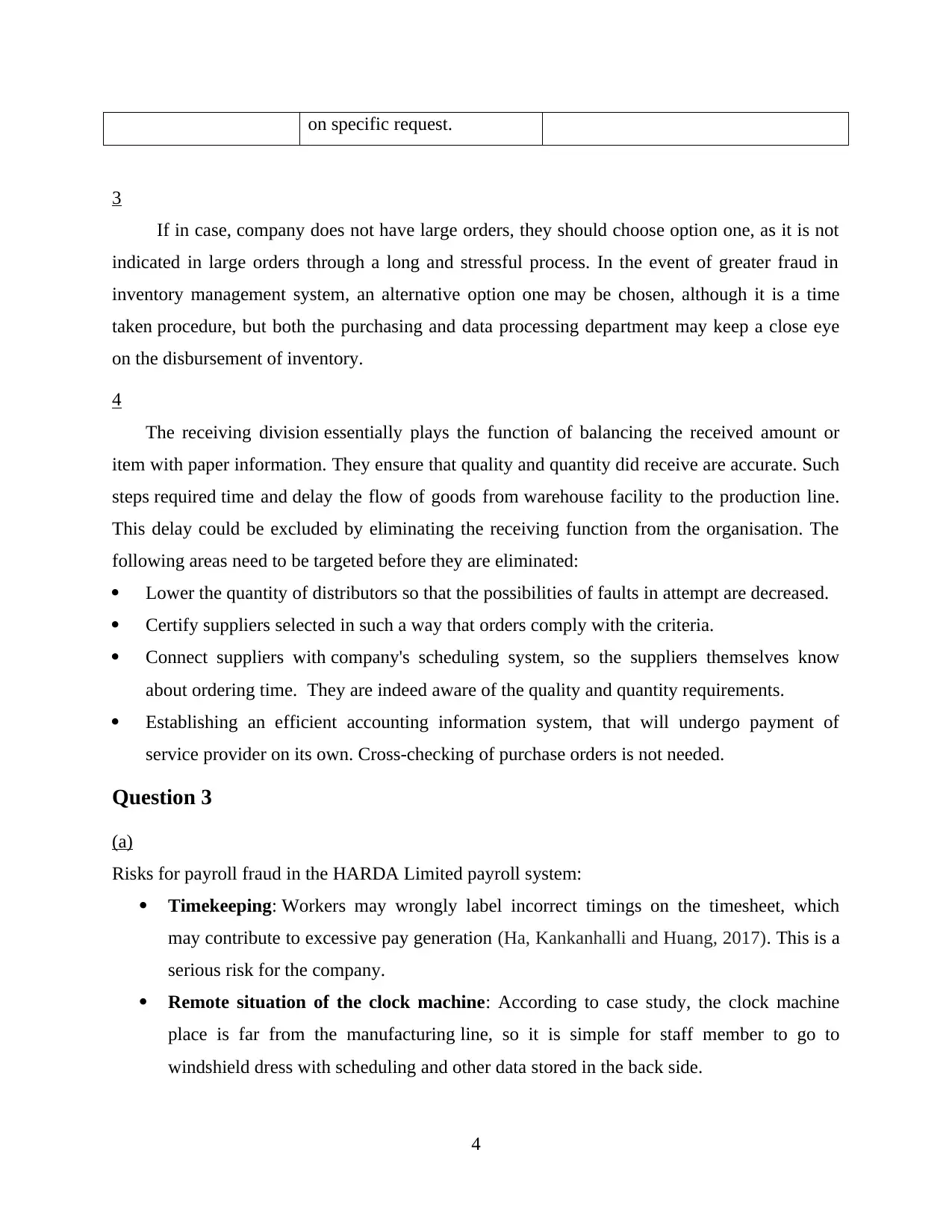
on specific request.
3
If in case, company does not have large orders, they should choose option one, as it is not
indicated in large orders through a long and stressful process. In the event of greater fraud in
inventory management system, an alternative option one may be chosen, although it is a time
taken procedure, but both the purchasing and data processing department may keep a close eye
on the disbursement of inventory.
4
The receiving division essentially plays the function of balancing the received amount or
item with paper information. They ensure that quality and quantity did receive are accurate. Such
steps required time and delay the flow of goods from warehouse facility to the production line.
This delay could be excluded by eliminating the receiving function from the organisation. The
following areas need to be targeted before they are eliminated:
Lower the quantity of distributors so that the possibilities of faults in attempt are decreased.
Certify suppliers selected in such a way that orders comply with the criteria.
Connect suppliers with company's scheduling system, so the suppliers themselves know
about ordering time. They are indeed aware of the quality and quantity requirements.
Establishing an efficient accounting information system, that will undergo payment of
service provider on its own. Cross-checking of purchase orders is not needed.
Question 3
(a)
Risks for payroll fraud in the HARDA Limited payroll system:
Timekeeping: Workers may wrongly label incorrect timings on the timesheet, which
may contribute to excessive pay generation (Ha, Kankanhalli and Huang, 2017). This is a
serious risk for the company.
Remote situation of the clock machine: According to case study, the clock machine
place is far from the manufacturing line, so it is simple for staff member to go to
windshield dress with scheduling and other data stored in the back side.
4
3
If in case, company does not have large orders, they should choose option one, as it is not
indicated in large orders through a long and stressful process. In the event of greater fraud in
inventory management system, an alternative option one may be chosen, although it is a time
taken procedure, but both the purchasing and data processing department may keep a close eye
on the disbursement of inventory.
4
The receiving division essentially plays the function of balancing the received amount or
item with paper information. They ensure that quality and quantity did receive are accurate. Such
steps required time and delay the flow of goods from warehouse facility to the production line.
This delay could be excluded by eliminating the receiving function from the organisation. The
following areas need to be targeted before they are eliminated:
Lower the quantity of distributors so that the possibilities of faults in attempt are decreased.
Certify suppliers selected in such a way that orders comply with the criteria.
Connect suppliers with company's scheduling system, so the suppliers themselves know
about ordering time. They are indeed aware of the quality and quantity requirements.
Establishing an efficient accounting information system, that will undergo payment of
service provider on its own. Cross-checking of purchase orders is not needed.
Question 3
(a)
Risks for payroll fraud in the HARDA Limited payroll system:
Timekeeping: Workers may wrongly label incorrect timings on the timesheet, which
may contribute to excessive pay generation (Ha, Kankanhalli and Huang, 2017). This is a
serious risk for the company.
Remote situation of the clock machine: According to case study, the clock machine
place is far from the manufacturing line, so it is simple for staff member to go to
windshield dress with scheduling and other data stored in the back side.
4
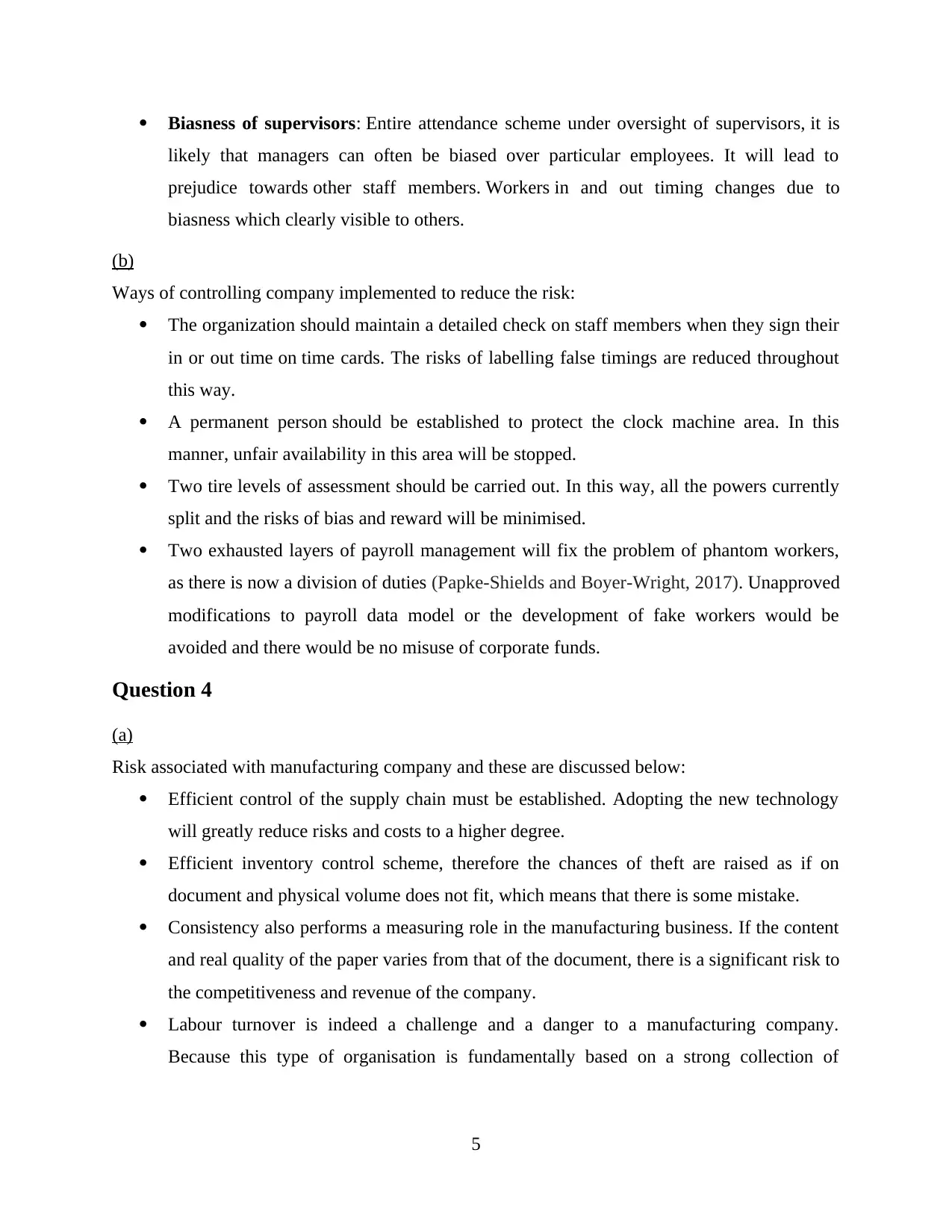
Biasness of supervisors: Entire attendance scheme under oversight of supervisors, it is
likely that managers can often be biased over particular employees. It will lead to
prejudice towards other staff members. Workers in and out timing changes due to
biasness which clearly visible to others.
(b)
Ways of controlling company implemented to reduce the risk:
The organization should maintain a detailed check on staff members when they sign their
in or out time on time cards. The risks of labelling false timings are reduced throughout
this way.
A permanent person should be established to protect the clock machine area. In this
manner, unfair availability in this area will be stopped.
Two tire levels of assessment should be carried out. In this way, all the powers currently
split and the risks of bias and reward will be minimised.
Two exhausted layers of payroll management will fix the problem of phantom workers,
as there is now a division of duties (Papke-Shields and Boyer-Wright, 2017). Unapproved
modifications to payroll data model or the development of fake workers would be
avoided and there would be no misuse of corporate funds.
Question 4
(a)
Risk associated with manufacturing company and these are discussed below:
Efficient control of the supply chain must be established. Adopting the new technology
will greatly reduce risks and costs to a higher degree.
Efficient inventory control scheme, therefore the chances of theft are raised as if on
document and physical volume does not fit, which means that there is some mistake.
Consistency also performs a measuring role in the manufacturing business. If the content
and real quality of the paper varies from that of the document, there is a significant risk to
the competitiveness and revenue of the company.
Labour turnover is indeed a challenge and a danger to a manufacturing company.
Because this type of organisation is fundamentally based on a strong collection of
5
likely that managers can often be biased over particular employees. It will lead to
prejudice towards other staff members. Workers in and out timing changes due to
biasness which clearly visible to others.
(b)
Ways of controlling company implemented to reduce the risk:
The organization should maintain a detailed check on staff members when they sign their
in or out time on time cards. The risks of labelling false timings are reduced throughout
this way.
A permanent person should be established to protect the clock machine area. In this
manner, unfair availability in this area will be stopped.
Two tire levels of assessment should be carried out. In this way, all the powers currently
split and the risks of bias and reward will be minimised.
Two exhausted layers of payroll management will fix the problem of phantom workers,
as there is now a division of duties (Papke-Shields and Boyer-Wright, 2017). Unapproved
modifications to payroll data model or the development of fake workers would be
avoided and there would be no misuse of corporate funds.
Question 4
(a)
Risk associated with manufacturing company and these are discussed below:
Efficient control of the supply chain must be established. Adopting the new technology
will greatly reduce risks and costs to a higher degree.
Efficient inventory control scheme, therefore the chances of theft are raised as if on
document and physical volume does not fit, which means that there is some mistake.
Consistency also performs a measuring role in the manufacturing business. If the content
and real quality of the paper varies from that of the document, there is a significant risk to
the competitiveness and revenue of the company.
Labour turnover is indeed a challenge and a danger to a manufacturing company.
Because this type of organisation is fundamentally based on a strong collection of
5
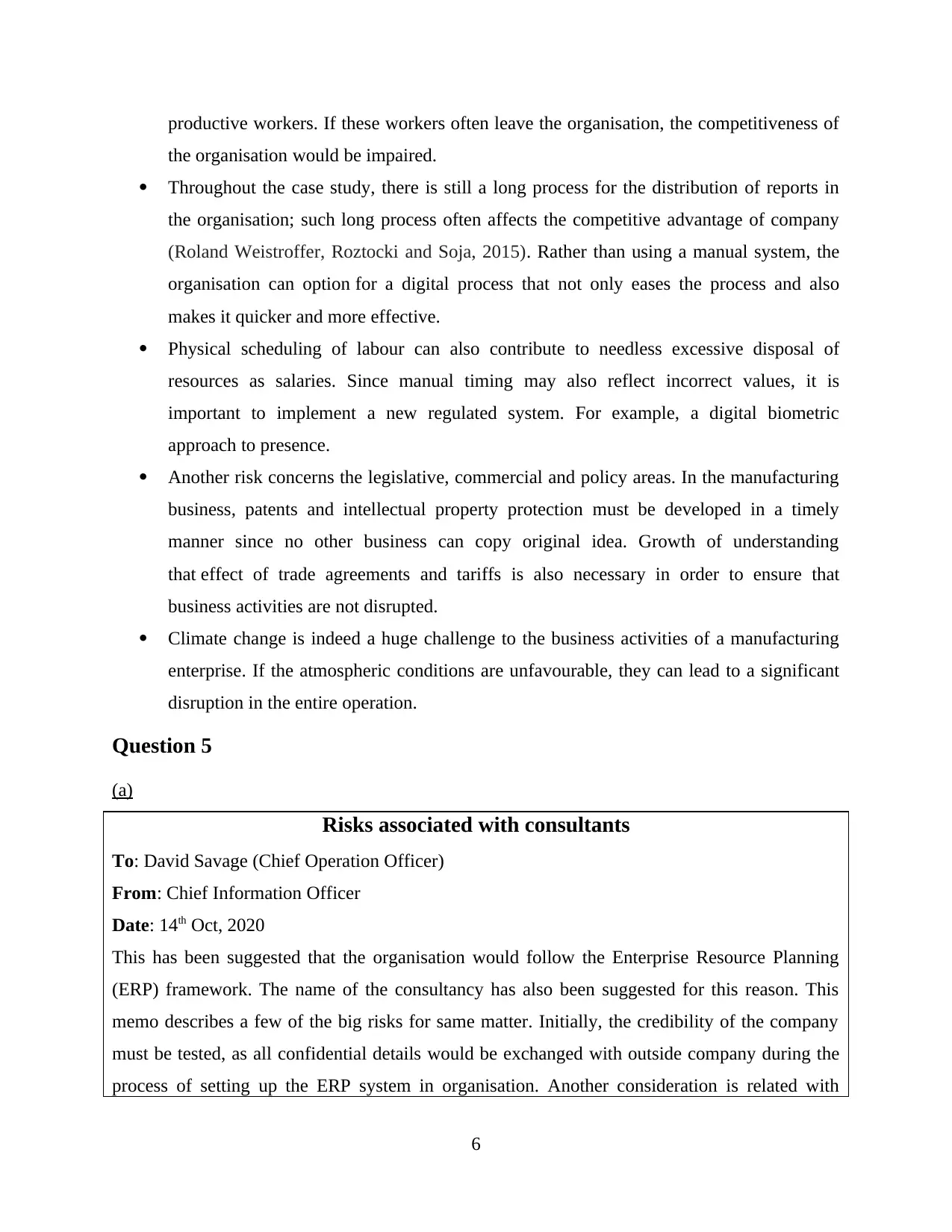
productive workers. If these workers often leave the organisation, the competitiveness of
the organisation would be impaired.
Throughout the case study, there is still a long process for the distribution of reports in
the organisation; such long process often affects the competitive advantage of company
(Roland Weistroffer, Roztocki and Soja, 2015). Rather than using a manual system, the
organisation can option for a digital process that not only eases the process and also
makes it quicker and more effective.
Physical scheduling of labour can also contribute to needless excessive disposal of
resources as salaries. Since manual timing may also reflect incorrect values, it is
important to implement a new regulated system. For example, a digital biometric
approach to presence.
Another risk concerns the legislative, commercial and policy areas. In the manufacturing
business, patents and intellectual property protection must be developed in a timely
manner since no other business can copy original idea. Growth of understanding
that effect of trade agreements and tariffs is also necessary in order to ensure that
business activities are not disrupted.
Climate change is indeed a huge challenge to the business activities of a manufacturing
enterprise. If the atmospheric conditions are unfavourable, they can lead to a significant
disruption in the entire operation.
Question 5
(a)
Risks associated with consultants
To: David Savage (Chief Operation Officer)
From: Chief Information Officer
Date: 14th Oct, 2020
This has been suggested that the organisation would follow the Enterprise Resource Planning
(ERP) framework. The name of the consultancy has also been suggested for this reason. This
memo describes a few of the big risks for same matter. Initially, the credibility of the company
must be tested, as all confidential details would be exchanged with outside company during the
process of setting up the ERP system in organisation. Another consideration is related with
6
the organisation would be impaired.
Throughout the case study, there is still a long process for the distribution of reports in
the organisation; such long process often affects the competitive advantage of company
(Roland Weistroffer, Roztocki and Soja, 2015). Rather than using a manual system, the
organisation can option for a digital process that not only eases the process and also
makes it quicker and more effective.
Physical scheduling of labour can also contribute to needless excessive disposal of
resources as salaries. Since manual timing may also reflect incorrect values, it is
important to implement a new regulated system. For example, a digital biometric
approach to presence.
Another risk concerns the legislative, commercial and policy areas. In the manufacturing
business, patents and intellectual property protection must be developed in a timely
manner since no other business can copy original idea. Growth of understanding
that effect of trade agreements and tariffs is also necessary in order to ensure that
business activities are not disrupted.
Climate change is indeed a huge challenge to the business activities of a manufacturing
enterprise. If the atmospheric conditions are unfavourable, they can lead to a significant
disruption in the entire operation.
Question 5
(a)
Risks associated with consultants
To: David Savage (Chief Operation Officer)
From: Chief Information Officer
Date: 14th Oct, 2020
This has been suggested that the organisation would follow the Enterprise Resource Planning
(ERP) framework. The name of the consultancy has also been suggested for this reason. This
memo describes a few of the big risks for same matter. Initially, the credibility of the company
must be tested, as all confidential details would be exchanged with outside company during the
process of setting up the ERP system in organisation. Another consideration is related with
6
Paraphrase This Document
Need a fresh take? Get an instant paraphrase of this document with our AI Paraphraser
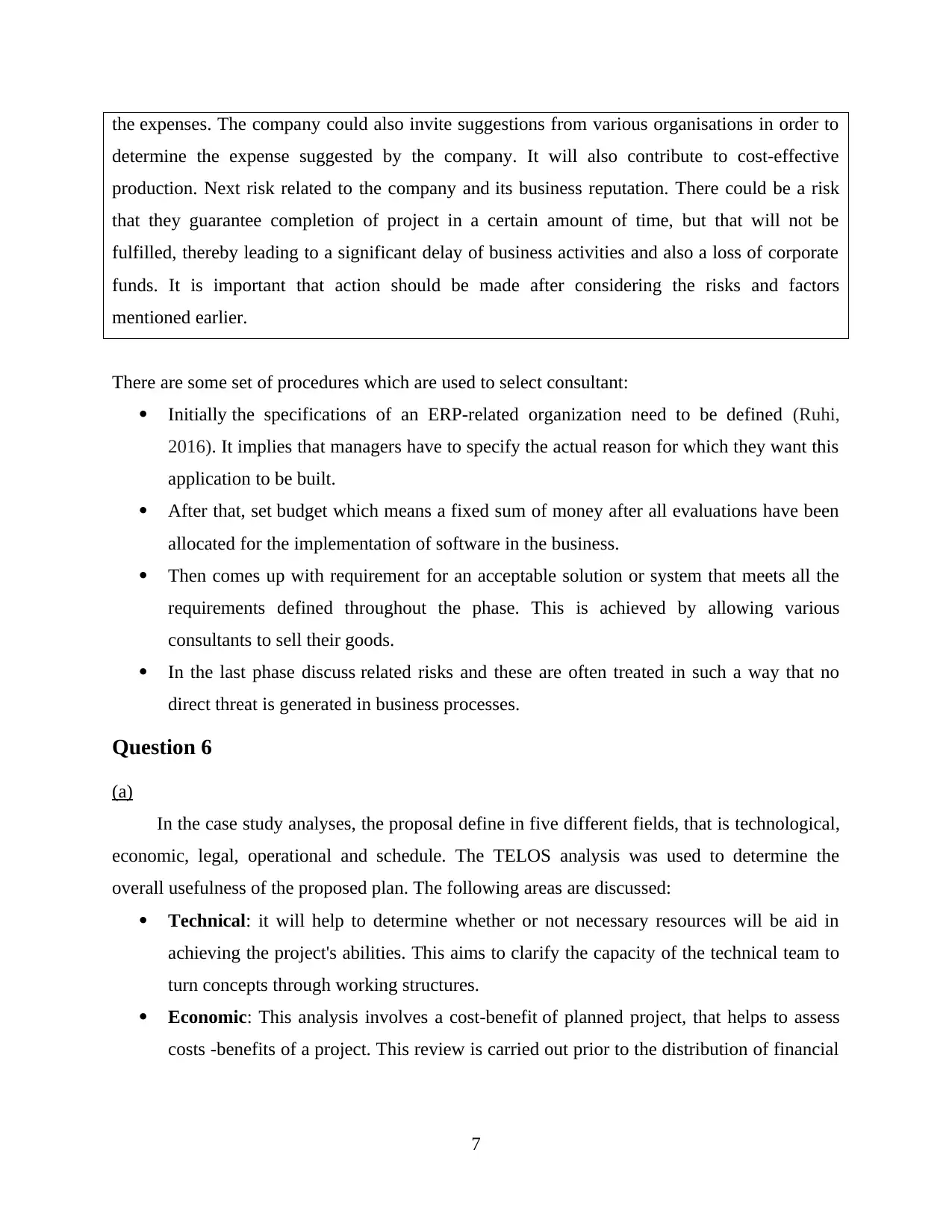
the expenses. The company could also invite suggestions from various organisations in order to
determine the expense suggested by the company. It will also contribute to cost-effective
production. Next risk related to the company and its business reputation. There could be a risk
that they guarantee completion of project in a certain amount of time, but that will not be
fulfilled, thereby leading to a significant delay of business activities and also a loss of corporate
funds. It is important that action should be made after considering the risks and factors
mentioned earlier.
There are some set of procedures which are used to select consultant:
Initially the specifications of an ERP-related organization need to be defined (Ruhi,
2016). It implies that managers have to specify the actual reason for which they want this
application to be built.
After that, set budget which means a fixed sum of money after all evaluations have been
allocated for the implementation of software in the business.
Then comes up with requirement for an acceptable solution or system that meets all the
requirements defined throughout the phase. This is achieved by allowing various
consultants to sell their goods.
In the last phase discuss related risks and these are often treated in such a way that no
direct threat is generated in business processes.
Question 6
(a)
In the case study analyses, the proposal define in five different fields, that is technological,
economic, legal, operational and schedule. The TELOS analysis was used to determine the
overall usefulness of the proposed plan. The following areas are discussed:
Technical: it will help to determine whether or not necessary resources will be aid in
achieving the project's abilities. This aims to clarify the capacity of the technical team to
turn concepts through working structures.
Economic: This analysis involves a cost-benefit of planned project, that helps to assess
costs -benefits of a project. This review is carried out prior to the distribution of financial
7
determine the expense suggested by the company. It will also contribute to cost-effective
production. Next risk related to the company and its business reputation. There could be a risk
that they guarantee completion of project in a certain amount of time, but that will not be
fulfilled, thereby leading to a significant delay of business activities and also a loss of corporate
funds. It is important that action should be made after considering the risks and factors
mentioned earlier.
There are some set of procedures which are used to select consultant:
Initially the specifications of an ERP-related organization need to be defined (Ruhi,
2016). It implies that managers have to specify the actual reason for which they want this
application to be built.
After that, set budget which means a fixed sum of money after all evaluations have been
allocated for the implementation of software in the business.
Then comes up with requirement for an acceptable solution or system that meets all the
requirements defined throughout the phase. This is achieved by allowing various
consultants to sell their goods.
In the last phase discuss related risks and these are often treated in such a way that no
direct threat is generated in business processes.
Question 6
(a)
In the case study analyses, the proposal define in five different fields, that is technological,
economic, legal, operational and schedule. The TELOS analysis was used to determine the
overall usefulness of the proposed plan. The following areas are discussed:
Technical: it will help to determine whether or not necessary resources will be aid in
achieving the project's abilities. This aims to clarify the capacity of the technical team to
turn concepts through working structures.
Economic: This analysis involves a cost-benefit of planned project, that helps to assess
costs -benefits of a project. This review is carried out prior to the distribution of financial
7
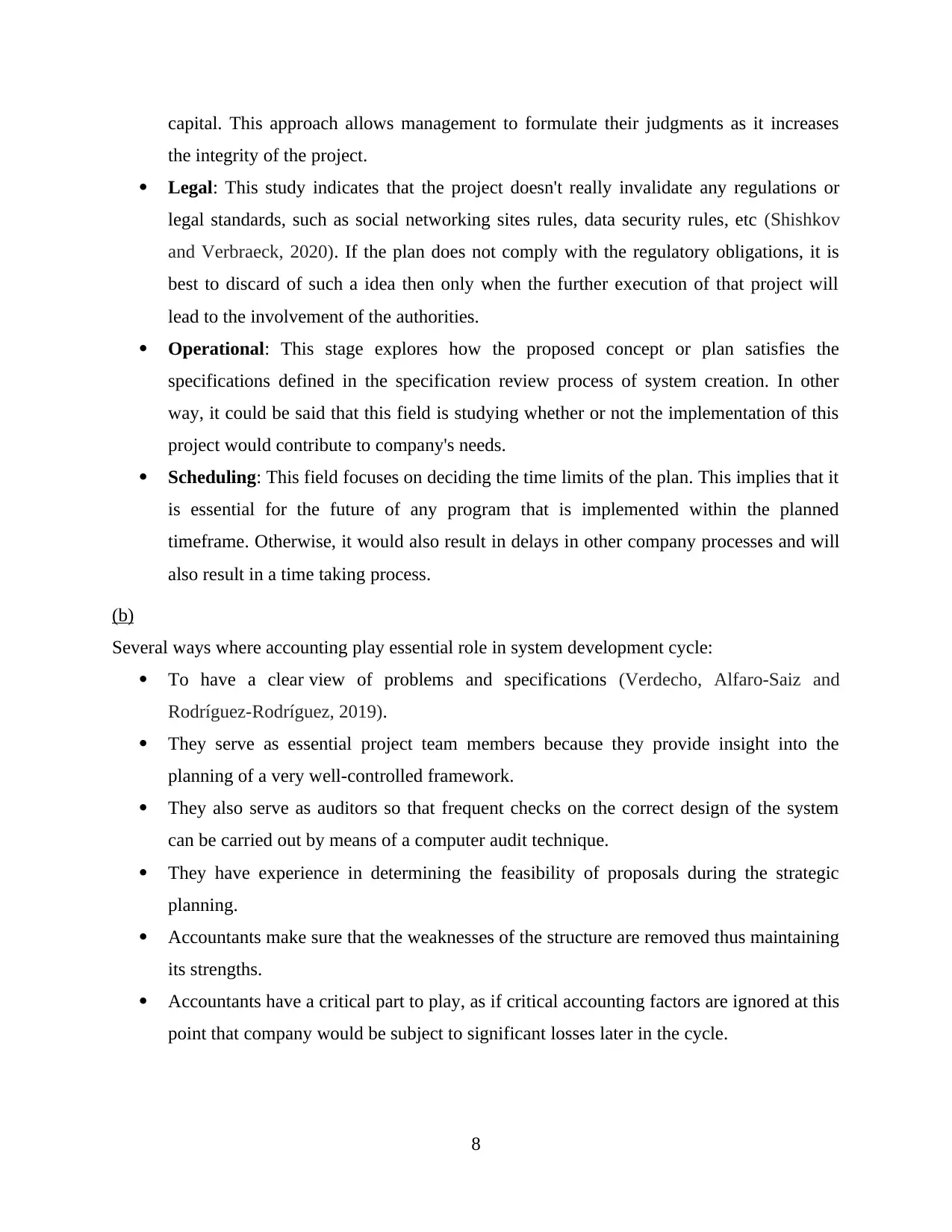
capital. This approach allows management to formulate their judgments as it increases
the integrity of the project.
Legal: This study indicates that the project doesn't really invalidate any regulations or
legal standards, such as social networking sites rules, data security rules, etc (Shishkov
and Verbraeck, 2020). If the plan does not comply with the regulatory obligations, it is
best to discard of such a idea then only when the further execution of that project will
lead to the involvement of the authorities.
Operational: This stage explores how the proposed concept or plan satisfies the
specifications defined in the specification review process of system creation. In other
way, it could be said that this field is studying whether or not the implementation of this
project would contribute to company's needs.
Scheduling: This field focuses on deciding the time limits of the plan. This implies that it
is essential for the future of any program that is implemented within the planned
timeframe. Otherwise, it would also result in delays in other company processes and will
also result in a time taking process.
(b)
Several ways where accounting play essential role in system development cycle:
To have a clear view of problems and specifications (Verdecho, Alfaro-Saiz and
Rodríguez-Rodríguez, 2019).
They serve as essential project team members because they provide insight into the
planning of a very well-controlled framework.
They also serve as auditors so that frequent checks on the correct design of the system
can be carried out by means of a computer audit technique.
They have experience in determining the feasibility of proposals during the strategic
planning.
Accountants make sure that the weaknesses of the structure are removed thus maintaining
its strengths.
Accountants have a critical part to play, as if critical accounting factors are ignored at this
point that company would be subject to significant losses later in the cycle.
8
the integrity of the project.
Legal: This study indicates that the project doesn't really invalidate any regulations or
legal standards, such as social networking sites rules, data security rules, etc (Shishkov
and Verbraeck, 2020). If the plan does not comply with the regulatory obligations, it is
best to discard of such a idea then only when the further execution of that project will
lead to the involvement of the authorities.
Operational: This stage explores how the proposed concept or plan satisfies the
specifications defined in the specification review process of system creation. In other
way, it could be said that this field is studying whether or not the implementation of this
project would contribute to company's needs.
Scheduling: This field focuses on deciding the time limits of the plan. This implies that it
is essential for the future of any program that is implemented within the planned
timeframe. Otherwise, it would also result in delays in other company processes and will
also result in a time taking process.
(b)
Several ways where accounting play essential role in system development cycle:
To have a clear view of problems and specifications (Verdecho, Alfaro-Saiz and
Rodríguez-Rodríguez, 2019).
They serve as essential project team members because they provide insight into the
planning of a very well-controlled framework.
They also serve as auditors so that frequent checks on the correct design of the system
can be carried out by means of a computer audit technique.
They have experience in determining the feasibility of proposals during the strategic
planning.
Accountants make sure that the weaknesses of the structure are removed thus maintaining
its strengths.
Accountants have a critical part to play, as if critical accounting factors are ignored at this
point that company would be subject to significant losses later in the cycle.
8
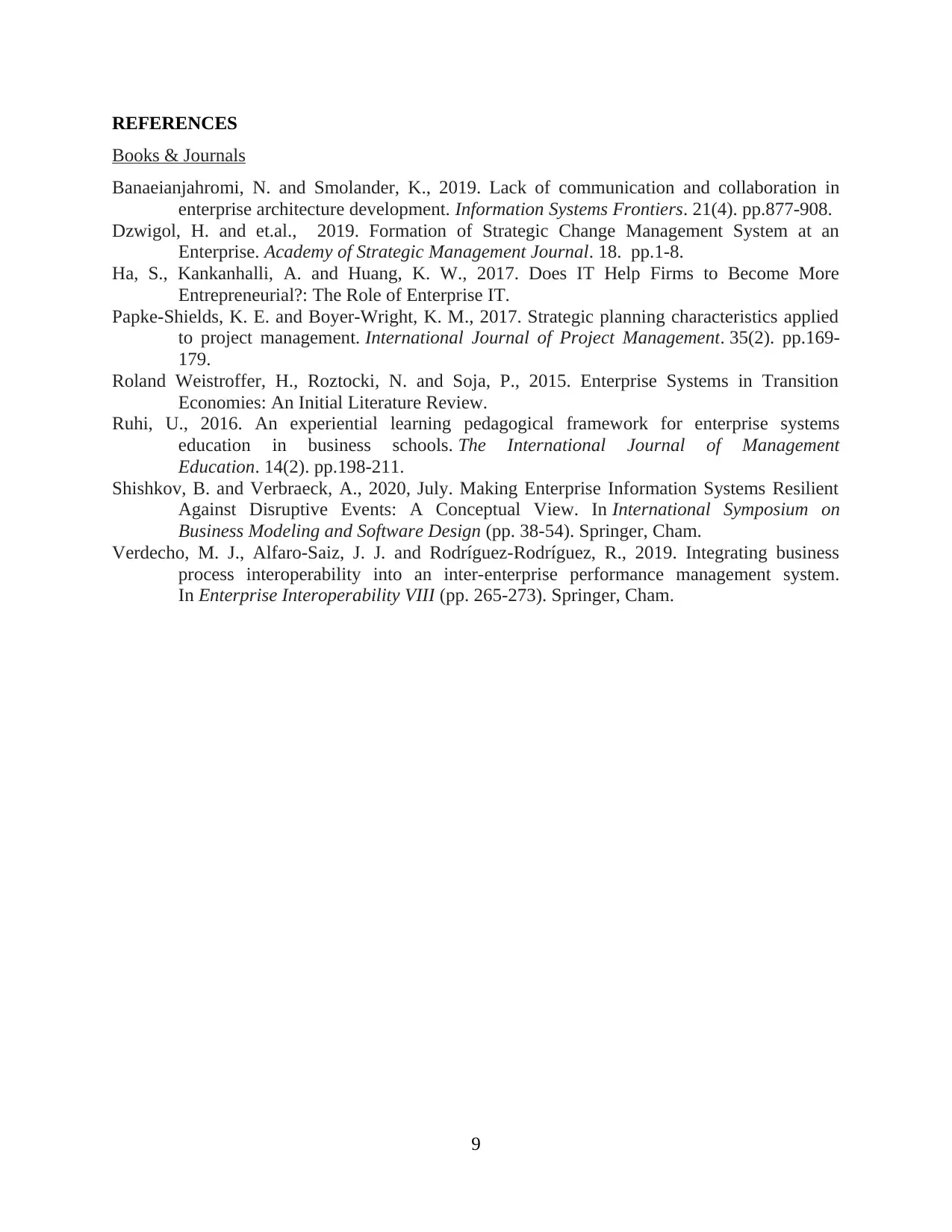
REFERENCES
Books & Journals
Banaeianjahromi, N. and Smolander, K., 2019. Lack of communication and collaboration in
enterprise architecture development. Information Systems Frontiers. 21(4). pp.877-908.
Dzwigol, H. and et.al., 2019. Formation of Strategic Change Management System at an
Enterprise. Academy of Strategic Management Journal. 18. pp.1-8.
Ha, S., Kankanhalli, A. and Huang, K. W., 2017. Does IT Help Firms to Become More
Entrepreneurial?: The Role of Enterprise IT.
Papke-Shields, K. E. and Boyer-Wright, K. M., 2017. Strategic planning characteristics applied
to project management. International Journal of Project Management. 35(2). pp.169-
179.
Roland Weistroffer, H., Roztocki, N. and Soja, P., 2015. Enterprise Systems in Transition
Economies: An Initial Literature Review.
Ruhi, U., 2016. An experiential learning pedagogical framework for enterprise systems
education in business schools. The International Journal of Management
Education. 14(2). pp.198-211.
Shishkov, B. and Verbraeck, A., 2020, July. Making Enterprise Information Systems Resilient
Against Disruptive Events: A Conceptual View. In International Symposium on
Business Modeling and Software Design (pp. 38-54). Springer, Cham.
Verdecho, M. J., Alfaro-Saiz, J. J. and Rodríguez-Rodríguez, R., 2019. Integrating business
process interoperability into an inter-enterprise performance management system.
In Enterprise Interoperability VIII (pp. 265-273). Springer, Cham.
9
Books & Journals
Banaeianjahromi, N. and Smolander, K., 2019. Lack of communication and collaboration in
enterprise architecture development. Information Systems Frontiers. 21(4). pp.877-908.
Dzwigol, H. and et.al., 2019. Formation of Strategic Change Management System at an
Enterprise. Academy of Strategic Management Journal. 18. pp.1-8.
Ha, S., Kankanhalli, A. and Huang, K. W., 2017. Does IT Help Firms to Become More
Entrepreneurial?: The Role of Enterprise IT.
Papke-Shields, K. E. and Boyer-Wright, K. M., 2017. Strategic planning characteristics applied
to project management. International Journal of Project Management. 35(2). pp.169-
179.
Roland Weistroffer, H., Roztocki, N. and Soja, P., 2015. Enterprise Systems in Transition
Economies: An Initial Literature Review.
Ruhi, U., 2016. An experiential learning pedagogical framework for enterprise systems
education in business schools. The International Journal of Management
Education. 14(2). pp.198-211.
Shishkov, B. and Verbraeck, A., 2020, July. Making Enterprise Information Systems Resilient
Against Disruptive Events: A Conceptual View. In International Symposium on
Business Modeling and Software Design (pp. 38-54). Springer, Cham.
Verdecho, M. J., Alfaro-Saiz, J. J. and Rodríguez-Rodríguez, R., 2019. Integrating business
process interoperability into an inter-enterprise performance management system.
In Enterprise Interoperability VIII (pp. 265-273). Springer, Cham.
9
1 out of 10
Related Documents
Your All-in-One AI-Powered Toolkit for Academic Success.
+13062052269
info@desklib.com
Available 24*7 on WhatsApp / Email
![[object Object]](/_next/static/media/star-bottom.7253800d.svg)
Unlock your academic potential
© 2024 | Zucol Services PVT LTD | All rights reserved.





